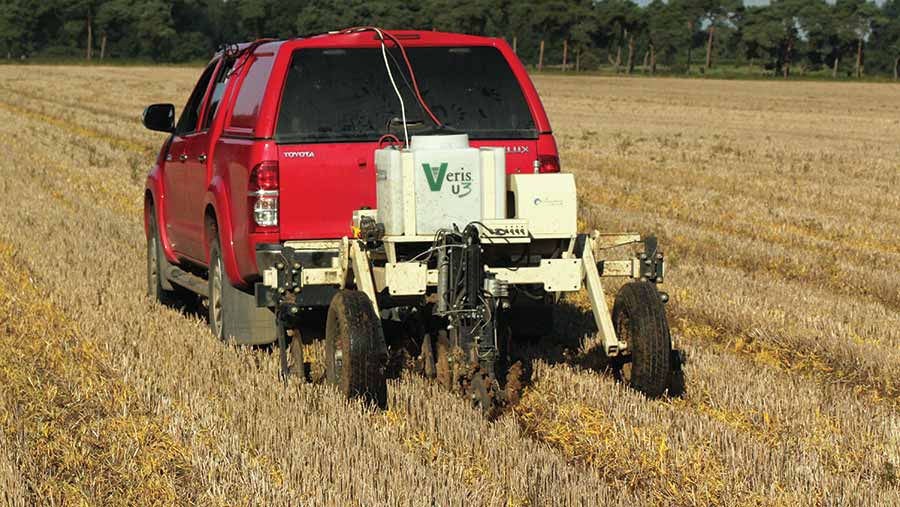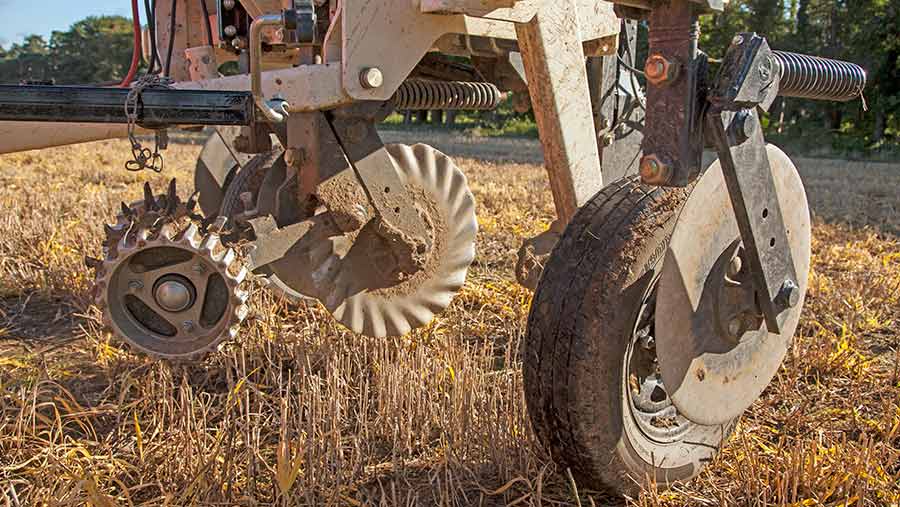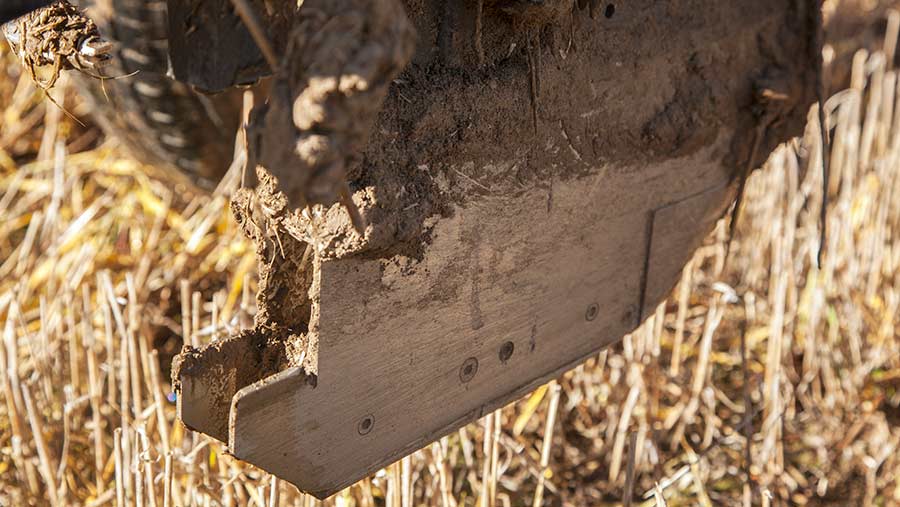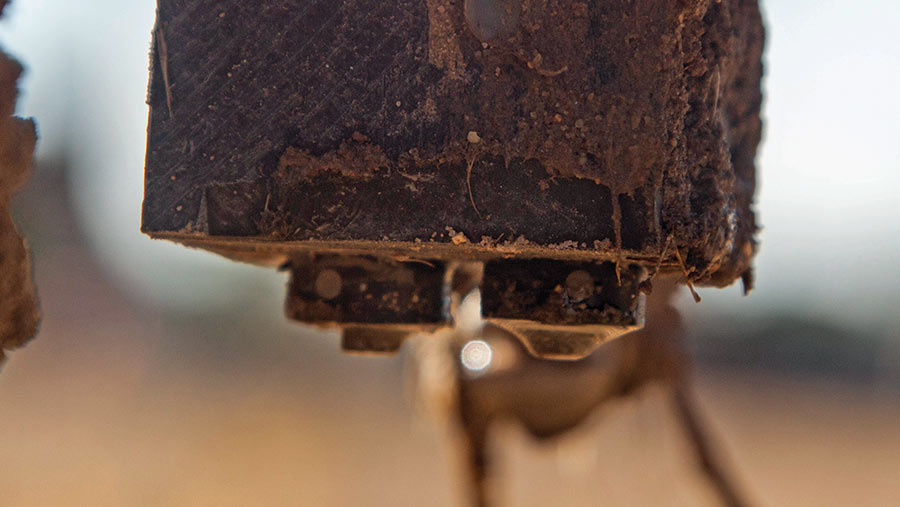High-tech soil scanner delivers margin-boosting data
 © Adam Clarke
© Adam Clarke The latest sensing technology to hit British shores is providing the data required to improve soil management and target inputs more efficiently than ever before.
A handful of companies have offered UK growers soil scanning services for several years, but their kit has so far only provided electro conductivity (EC) data to establish soil type.
This allows growers to divide their fields into zones, which can then be targeted with traditional soil sampling and help create variable application maps for nutrients and seed.
See also: Clever invention makes nematode sampling a doddle
US technology
At the end of 2014, however, agronomy provider Agrovista raised the bar by importing a piece of American gadgetry that not only scans soil type as it moves, but also measures soil organic matter and pH.
While the MSP3 from Kansas-based tech company Veris did its job perfectly well, it required a 70-80hp tractor and a remote hydraulic system to pull and operate its functions.
Graeme Barrett, precision agronomy manager at Keith Mount Liming – which runs the machine in conjunction with Agrovista – says it would be too expensive to invest in a tractor solely for the Veris and it’s also impractical for covering large areas.
“You can’t really use a tractor to shift the MSP3 from farm to farm as it is too slow, so we were lifting it on and off a trailer towed by a pickup.
“We were then having to borrow a tractor from the customer and that required a time-consuming set up whenever it was moved between jobs,” he adds.
New scanner
To solve these issues, it was decided to replace the MSP3 with Veris’s lighter and more compact U3 scanner, which has been put to work in the UK this summer for the first time.
With its own self-contained hydraulic system, it can be towed by a 4×4 utility vehicle (UTV) or pickup at speeds of up to 15mph and output can hit 150ha per day in favourable conditions.
Driven in parallel lines 12m apart, EC, organic matter and pH results are fed to a laptop or tablet installed with Veris’s FieldFusion software.
This logs the results data and provides the operator with real-time information via a dashboard, helping him or her keep an eye on all three data streams and ensuring they are working as they should be.
Advantages
One of the advantages of using the Veris over a standard soil testing system is that it offers double the sampling intensity by working on a 0.5ha grid rather than the traditional 1ha layout.
For pH and organic matter, this means growers get more robust analysis of levels in the soil for more accurate variable rate application maps, which helps make better use of costly remedial products.
The EC results help growers target traditional sampling by soil type for variable rate phosphate and potash, plus draw up variable rate seeding plans to achieve optimum plant populations across varying soil textures.
While soil type scanning is a one-off exercise, the U3 can be used in subsequent years to monitor how soil conditioning inputs such as lime and manures are performing and amend applications accordingly.
Slope and curve
Interestingly, the U3 also uses elevation and GPS data to map slopes and curves and when combined with soil type and organic matter data, can create soil leaching risk and water holding capacity maps.
Agrovista precision farming expert Jack Harris explains that the leaching risk maps can be used to fine tune nitrogen applications, reducing rates where the nutrient is more likely to be lost and vice versa.
“If you are in a nitrate vulnerable zone it also helps minimise pollution, which is beneficial for the environment and using the technology in this way might become a legal requirement in the future,” he adds.
Smarter irrigation
Water holding capacity maps are also useful, helping growers predict likely nutrient availability and for root and veg crop growers using irrigation, better target moisture probes to monitor soil moisture deficit.
With potatoes, for example, allowing soils to dry out too much at tuber initiation can trigger common scab epidemics – a problem seen in crops this harvest after the hot and dry June.
Knowing where the driest zones of a field are will help place probes where water will be needed first, telling growers when to irrigate and ensuring all of the crop has adequate water to maintain quality and yield.
Mr Harris says layering all the information over yield data can also allow growers to correlate each parameter with crop performance and where it is poor, it might mean inputs are reduced relative to potential.
“It isn’t necessarily about evening crops up, it’s about improving gross margin across the field,” he adds.
Compatibility
Any data generated using Veris’s software can be imported into other farm mapping software, including Farmworks Office or MapIT Pro, for fine-tuning.
Once maps are created, they are compatible with farm management software such as GateKeeper or Muddy Boots, plus all machinery manufacturers’ variable rate application equipment.
As part of its service, both Keith Mount and Agrovista offer a grower consultation on how best to use all the information, which is presented in paper and/or raw data form, depending on preference.
A basic package for on-the-go soil type scanning, pH and organic matter testing, plus four calibration soil samples per field to ensure accuracy, costs in the region of £20/ha. Extra maps for leaching risk or water holding capacity are an additional £2.50/ha each.
Veris U3 – how does it work?
EC scanning
Three vertical discs cut into the soil, with the outer two emitting an electrical current. The centre disc picks up the voltage drop to a depth of 2ft at one-second intervals. The control unit geo-references each reading using GPS.
Sands have a low conductivity, silts have a medium conductivity and clays have a high conductivity, so from the readings accurate maps of changes in soil texture across a field can be drawn up from the data.

© Adam Clarke
Soil organic matter sensing
Soil organic matter readings are taken using a dual-wavelength near infrared sensor enclosed in a runner shank.
Two leading discs in a V configuration clear out trash and the runner shank cuts a 2in slot to expose clean, moist soil.
The soil’s colour relates accurately to organic matter content and the sensor then takes reflectance readings once every second through a sapphire window as it passes through the slot.
All information is geo-referenced via GPS.

© Adam Clarke
pH testing
The final part of the process is the soil pH measurement. The machine is stopped at 25 100m intervals, depending on desired sampling intensity, and two ion-selective glass electrodes are lowered and pressed against the bottom of the slot by a small hydraulic ram.
The electrodes are sensitive to hydrogen ions and their concentration in the soil dictates soil pH.
The U3 takes an average reading from its two electrodes, but if the difference between individual results is greater than 0.1 on the pH scale, the data is thrown out as erroneous.

© Adam Clarke
Topography
While in operation, the Veris U3 uses GPS and elevation data to record the slope and curve of the land, identifying any high and low spots for the production of water holding capacity and leaching risk maps.
Calibration
Each component of the one-pass process is calibrated before every job to ensure the machine is giving accurate and reliable readings.
For EC, a voltmeter is used to check current and voltage drop. The organic matter sensor has black and white plates passed under it and for pH, two buffer solutions – one acid and one alkali – with a known pH are used to submerge the electrodes.
All readings are cross checked on the operating software, with the whole calibration process taking about 15 minutes.
In addition to calibrating hardware, four soil samples are taken across each field and sent away for analysis. Results are adjusted accordingly if there are any small discrepancies between machine and laboratory.

©FLPA/Rex/Shutterstock

